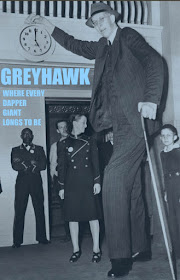At one time there were as many guilds as you could ever hope to find in one location in the city of Dyvers but that changed after Greyhawk's guilds began to dominate commerce in the region and the Great Kingdom fell to the wayside. Already the city's merchants had been forming companies to explore new lands and to establish new trade in distant lands. Now they became more prominent as the people began to fully reject the old ways and to organize themselves more effectively borrowing liberally from the mercantile companies.
Gone were the old power structures as the city rejected all the old ways. Where once the leader of the guild was either the most powerful or influential member among the elite now with the rise of companies it was the individual voted into office by all of the shareholders (a title that varied from group to group). The city became a political machine and ground those who couldn't navigate it down to dust. As a result the city has become a City of Companies, small and large. Adventurers, mercenaries, markets, teachers, laborers, and skilled artisans: nearly every one you meet in the city is a part of some company; and yet no one who holds power in the city's elected offices can have been in a company within the last ten years.
Those are ten lean years.
Let's say that you wanted to make your own company to be used in your home game set in Dyvers; how would you go about doing it? My answer is make your own up as you go while drinking Long Island Iced Teas and screaming at the fucking Bears as they lose another game; but, you know, your mileage may not be very far on that sort of cocktail. So here's a chart to help you out, kids.
Creating your own Dyvers Company
Process:
1) Roll on the d6 Company Theme table.
2) Roll or pick your favorite out of the theme.
3) Repeat as many times as you like.
4) Roll on the d30 adjective table
5) Roll as many times as you like
6) Combine them as best suits your sensibilities.
Examples:
The Terribly, Ugly Jackasses
The Ring-Ring Mule Distributors
Tom's Ogre Furnace
Anna's Embittered Terrapin Guns
1d6 Company Theme
1 Animal
2 Vegetable / Fruit
3 Mineral
4 Monster
5 Occupation
6 Person
7 Machine
8 Object
1d20 Animal
1 Monkey
2 Mule
3 Lion
4 Hare
5 Jackass
6 Turtle
7 Horse
8 Lamb
9 Skunk
10 Opossum
11 Bear
12 Raccoon
13 Snake
14 Terrapin
15 Crocodile
16 Rat
17 Dog
18 Cat
19 Turkey
20 Beaver
1d20 Vegetable / Fruit
1 Carrot
2 Cucumber
3 Potato
4 Yam
5 Pumpkin
6 Kale
7 Lettuce
8 Spinach
9 Peach
10 Pear
11 Pecan
12 Peanut
13 Walnut
14 Strawberry
15 Tomato
16 Grape
17 Water Chestnut
18 Avocado
19 Squash
20 Kumquat
1d20 Mineral
1 Gold
2 Pyrite
3 Cubanite
4 Pyromorphite
5 Lazulite
6 Wardite
7 Vesuvianite
8 Barthite
9 Sphalerite
10 Creedite
11 Koettigite
12 Helidor
13 Amethyst
14 Endlichite
15 Adamite
16 Manganadamite
17 Silver
18 Copper
19 Malachite
20 Chalcanthite
1d20 Monster
1 Flumph
2 Ogre
3 Goblin
4 Troll
5 Dragon
6 Giant
7 Demon
8 Devil
9 Golem
10 Were-(roll on 1d20 Animal Table)
11 Rakshasa
12 Vampire
13 Zombie
14 Umber-Hulk
15 Aboleth
16 Mind Flayer
17 Gorgon
18 Hag
19 Modron
20 Mongrelman
1d20 Occupation
1 Baker
2 Distributor
3 Tailor
4 Boatswain
5 Weatherman (or woman depending on your needs and mood)
6 Fishmonger
7 Bar Hop
8 Musician
9 Physician
10 Alchemist
11 Laborer
12 Scribe
13 Fisherman (or woman depending on your needs and mood)
14 Hunter
15 Tanner
16 Trader / Merchant
17 Inn Keeper
18 Gambler
19 Prostitute
20 Comedian
1d20 Person
1 Oscar
2 Anna
3 Maxwell
4 Jennifer
5 David
6 Christine
7 James
8 Megan
9 Luke
10 Sylvia
11 Norvel
12 Zelphia
13 Lester
14 Della
15 Earl
16 Peggy
17 Charles
18 Alisha
19 Thomas
20 Jaimie
1d20 Machine
1 Clock
2 Television
3 Gun
4 Pen
5 Canon
6 Dumbwaiter
7 Oven
8 Furnace
9 Jukebox
10 Tractor
11 Carriage
12 Crane
13 Escalator
14 Power Wheel
15 3D Printer
16 Truck
17 Tank
18 Phone
19 Fan
20 Elevator
1d20 Object
1 Book
2 Door
3 Gate
4 Rose Petal
5 Thorn
6 Guitar
7 Stocking
8 Picture
9 Bank
10 Chest
11 Funnel
12 Model
13 Home
14 Dice
15 Cards
16 Umbrella
17 Pry Bar
18 Hammer
19 Wrench
20 Jacket
1d30 Adjective
1 Ugly
2 Morose
3 Violent
4 Drunken
5 Slovenly
6 Bucolic
7 Trustworthy
8 Nonplussed
9 Disinterested
10 Forgotten
11 Embittered
12 Hidden
13 Worthless
14 Diabolic
15 Exquisite
16 Beautiful
17 Dishonest
18 Worthy
19 Friendly
20 Lackadaisical
21 Holy
22 Blasphemous
23 Ambidextrous
24 Disoriented
25 Tardy
26 Poignant
27 Unfinished
28 Numerous
29 Great
30 Terrible
There you have it. Now have fun making up the names for your own Dyvers styled Companies!























